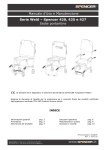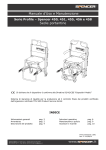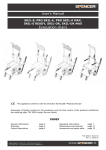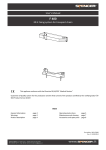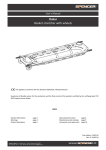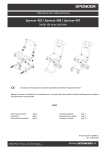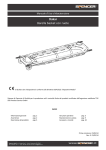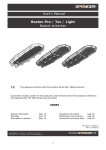Download User's Manual Weld Series – Spencer 420, 425 and 427 Transport
Transcript
User’s Manual Weld Series – Spencer 420, 425 and 427 Transport chairs This appliance conforms with the Directive 93/42/CEE “Medical Devices” Guarantee of Quality system for the production and the final control of the products certified by the notifying body TÜV SÜD Product Service GmbH INDEX General information Warnings Description of product page 2 page 2 page 5 Operating instructions Maintenance and cleaning Accessories and spare parts page 6 page 8 page 10 First edition: 25/08/09 Rev. 1: 21/11/12 1 Thank you for choosing a Spencer product 1. GENERAL INFORMATION 1.1 Aim and contents The aim of this manual is to supply all the information necessary so that the client, will not only attain adequate use of the appliance, he will also be capable of using the instrument in the most autonomous and secure way possible. This includes information regarding technical aspects, functioning, maintenance, spare parts and safety. 1.2 Conservation of the instruction manual The instruction and maintenance manual must be kept together with the product, for the whole life of the device, inside the specially provided container and above all, away from any substances or liquids which could compromise perfect legibility. 1.3 Symbols used Symbol Meaning General or specific warning See instructions for use Lot number Serial number Product code The product is compliant with the specifications of the Directive 93/42/CEE 1.4 Servicing requests For any information regarding the use, maintenance and installation, please contact the Spencer Customer Care Service on tel. 0039 0521 541111, fax 0039 0521 541222, e-mail [email protected] or write to Spencer Italia S.r.l. - Strada Cavi, 7 - 43044 Collecchio (Parma) - ITALY. In order to facilitate the assistance service, please always indicate or communicate the serial number (SN) or lot number (LOT) shown on the label applied on the box or on the device. 1.5 Demolition When the devices are no more suitable for being used, if they haven’t been contaminated by any particular agents, they can be disposed of as normal solid waste, otherwise follow the current regulations about demolition. 1.6 Labelling Each device has got an identifying label, positioned on the device itself and/or on the box. This label includes information about the manufacturer, the product, CE mark, lot number (LOT). It must never be removed or covered. 2. WARNINGS 2.1 General warnings • The product must be used by trained personnel only, having attended specific training for this device and not for similar products. • Training routines must be registered on a special register in which the names of those trained, of the trainers, date and place are indicated. This register which will certify the eligibility of the operators to use the Spencer device has to be kept for a period of 10 years after the disposal of the device itself. This register will be made available to the Competent Authorities and/or manufacturer if requested. • Spencer Italia S.r.l. is always at your disposal to plan trainings on products. • Before carrying out any kind of operation on the appliance (training, installation, use), the operator must carefully read the enclosed instructions, paying particular attention to the correct safety precautions and to the procedures to be followed for installation and for correct use. • If the instructions belong to another device and not the device received, inform the manufacturer immediately and avoid use of the device. • In the case of any doubts as to the correct interpretation of the instructions, please contact Spencer Italia S.r.l. for any necessary clarifications. • Do not allow untrained persons to help during the use of the device, because they could cause damage to the patient or to themselves. • Regularly check the appliance, carry out the prescribed maintenance and respect the average life span, as indicated by the manufacturer in this user’s manual. • Before each use of device the perfect operating state of the device must be checked as specified in the Instruction manual. If any damage or abnormalities which could in any way influence the correct functioning and the safety of the device, of the patient and or of the user are detected, the device must be immediately removed from service and the manufacturer must be contacted. 2 • • • • • • • • • • • • • • • • • • • • • • If any failure or incorrect functioning of the device is detected, it must be immediately substituted with a similar item so that the rescue procedures are guaranteed without any interruption. Use of the device in anyway other than described in this manual is forbidden. Do not alter or modify in any way the appliance; any such interference could cause malfunctions and injury to the patient and/or rescuer. The appliance must not in any way be tampered with (modification, adjustment, addition, replacement). In such cases all responsibility will be denied for any malfunctions or injuries caused by the appliance itself; moreover CE certification and product warranty will be considered void. Those who modify or have modified, prepare or have prepared medical appliances in such a way that they no longer serve the purpose for which they were intended, or no longer supply the intended service, must satisfy the valid conditions for the introduction onto the market. Handle with care. Ensure that all the necessary precautions are taken in order to avoid the hazards that can arise as the result of contact with blood or body fluids. Register and store with these instructions: lot number, place and date of purchase, first date of use, date of checks, name of users, any comments. When the device is being used, the assistance of qualified staff must be guaranteed. Do not store the device underneath any heavy objects which could cause structural damage. Store in a cool, dry, dark place and do not expose to direct sun. Store and transport device in its original packaging. The device not be exposed to or come into contact with any source of combustion or inflammable agents. Position and adjust the device taking care not to cause any obstruction to rescuers and or any other rescue equipment. Attention: laboratory testing, post production tests, instruction manuals cannot always consider every possible scenario for use. This means that in some cases the performance of the product could be notable different from results to date obtained. Instructions are continually being updated and are under tight surveillance of fully qualified staffs with adequate technical formation. With reference to the D. Lgs. 24th February 1997, n. 46 emended by D. Lgs. 25/01/2010, n. 37 – Acknowledgement of Directive 93/42/CEE and 2007/47/CE, we remind both public and private operators that they are obliged to report any accident that involves any medical device to the Ministry of Health and to the Manufacture as specified and within time given by the European regulations. In addition, both public and private operators are obliged to inform the manufacturer of any measures that should be adopted to make the steps necessary to guarantee the safety and the health of the patients and the users of any medical device. As a Distributor or End Users of products manufactured and/or marketed by Spencer Italia S.r.l., you are strictly required to have a basic knowledge of any legal requirements applying to the devices contained in this supply that are in power in the goods final destination Country (including laws and norms regarding technical specifications and / or safety requirements) and therefore you are also strictly required to have the necessary knowledge to guarantee all aspects regarding the total conformity of the products to the regulations in the relevant territory. Promptly notify Spencer Italia S.r.l. regarding any revisions to be made by manufacturer in order to guarantee the conformity of the product to the territory’s legal specifications (including those resulting from rules and/or norms of other nature). Act, with all due care and diligence, and contribute to ensure conformity to general safety requirements of all devices marketed in the territory, by providing final users with all necessary information for carrying out periodical checks on their devices, as specified in the relevant user manual. Actively contribute to product safety checks on products sold, by communicating any relevant risk analysis information both to the manufacturer and to any competent authorities so that the necessary action can be promptly taken. You are aware that in the event of any failure to conform to the above mentioned requirements you will be deemed fully responsible for all damages that might occur. Therefore we expressly disclaim any responsibility and/or liability for your non-compliance with the present “Regulatory provisions”. 2.2 Specific warnings • Establish a maintenance program and periodic testing, identifying a reference employee. The person to whom the ordinary maintenance of the device is entrusted must ensure the basic requirements foreseen by the manufacturer in the user’s manual. • Training routines must be registered on a special register in which the names of those trained, of the trainers, date and place are indicated. This register which will certify the eligibility of the operators to use the Spencer device has to be kept for a period of 10 years after the disposal of the device itself. This register will be made available to the Competent Authorities and/or manufacturer if requested. • Use only accessories/spare parts that are original or approved by Spencer Italia S.r.l., in order to carry out any operation without causing any alteration or modification to the device, otherwise we assume no responsibility for the proper functioning or damage resulting from device to the patient or the operator and warranty and will be considered void according to the compliance to the Medical Device Directive 93/42/CEE. • Always respect the maximum capacity of the device, as indicated in this user's manual. Maximum load capacity means the total weight distributed according to the human anatomy. In determining the load of the total weight on the product, the operator must consider the weight of the patient, the equipment and the accessories. Moreover, the operator must consider that the overall dimensions of the patient do not reduce the functionality of the device. 3 • • • • • • • • • • • • • • • • • • • • • • Never leave the patient unassisted on the device, because he may be injured. The device and all its components, after washing, should be allowed to dry completely before storing. Lubrication must be carried out after cleaning and complete drying. Follow the procedures approved by the Emergency Medical Services for the immobilization and transport of patients. Follow the procedures approved by the Emergency Medical Services for the positioning and transport of the patient. Do not use the device if it is pierced, torn or frayed. Make sure, before lifting, that the operators have a firm grip on the device. Avoid pulling the device on rough surfaces. Do not lift by crane or other mechanical lifts. The device is a chair for patients handling and cannot be used as a stationing device. First practice with an empty chair in order to get used to the way in which the stretcher manoeuvres. For the use of the device, at least two operators in suitable physical conditions are needed; they must therefore have strength, balance, coordination, and common sense and must be trained on the correct functioning of the device Spencer chair. For techniques for loading particularly heavy patients, for rescue operations on steep ground or in unusual circumstances, it is recommended the presence of more operators (not just two as required under standard conditions). The maximum weight sustained by each rescuer must comply with requirements prescribed by the law of the Country, concerning Health and Safety at Work. Before each use, check the integrity of the belts and their hooks, as specified in the user’s manual. In case of malfunction or damage that may compromise the function and safety of the device, patient or operator, it is necessary to replace the belts. Always immobilize the patient, using the belts supplied by the manufacturer, since the lack of immobilization can cause serious damage. Use the chair only as described in this user's manual. Pay a lot of attention to possible obstacles (water, ice, debris, etc.) on the route of the stretcher, because they could cause loss of balance for the operator and compromise the proper functioning of the device. If you can not set the path free from obstacles, choose an alternative path. For slopes greater than 10 mm the device must be raised, making sure to grab it on the frame. Condensation, water, ice and dust accumulation can affect the correct operation of the device, making it unpredictable and causing a sudden alteration of the weight that operators have to bear. The chairs are certified for use with dedicated Spencer fastening systems, it is therefore forbidden the use of fasteners not approved by the manufacturer. Fastening systems that have not been approved may alter the structural and functional characteristics of the chair. It is not permitted to use the chair transport in the open position, even if provided with the appropriate fasteners. 2.3 Contraindications and side effects The use of this device, if used as described in this manual, does not present any contraindications or collateral effects. ZIONE 2.4 Physical requirements of the operators Profile Series transport chairs are destined to professional use only. The rescue operators must have the following minimum requirements: • physical capacity for operating the device • be able to seize the device firmly with both hands • have strong back, arms and legs for lifting, pushing and pulling the chair • have a good muscular coordination The operators must be trained in efficient, effective and safe patient handling. This chair requires the employment of at least two operators equipped with strength, balance, coordination and common sense. Patient loading procedures for extremely heavy patients, operations in rough terrain and in particular situations more operators may be needed (not only two as in normal conditions). The capacities of the various operators must be considered before determining his role in the employment of the chair. 4 3. DESCRIPTION OF PRODUCT 3.1 Intended use Weld Series transport chairs Spencer 420, 425 e 427 are medical devices designed and constructed to allow the transport of patients in a sitting position from the point of intervention until the ambulance; therefore it is not permitted to use the open chair inside the emergency vehicles, even if provided with suitable fastening systems. These models are used in all cases in which, because of the particular conditions of the place of intervention, it is not possible to use devices having a greater encumbrance. Weld Series transport chairs Spencer 420, 425 and 427 are characterized by an extremely low weight and by the simplification of closing and opening operations, which are completely automatic. It is not expected that the patient can intervene on the device. 3.2 Main components Fig. A n° 1 2 3 4 5 6 7 8 9 10 11 Description of component Backrest cover Backrest frame Back handles Seat cover Compass for closure/opening Front, left telescopic handle Black wheel Ø 125 mm Black wheel Ø 100 mm with brake Footrest Front, right telescopic handle Seat frame Material PVC Steel Steel / rubber PVC Steel Aluminium / rubber Polyprolylene Polyprolylene Aluminium Aluminium / rubber Steel 5 3.3 Models This model could be modified, with reference to codes and/or descriptions without any previous notification. ST10420A ST20420A ST00420A ST10425B ST20425B ST11425A Spencer Spencer Spencer Spencer Spencer Spencer 420 420 420 425 425 427 Transport chair with two wheels, silver Transport chair with two wheels, yellow Transport chair with two wheels, blue Transport chair with four wheels, silver Transport chair with four wheels, yellow Comfort chair with four wheels 3.4 Technical data Characteristics Height open (mm) Height folded (mm) Width (mm) Thickness folded (mm) Length (mm) Length with open handles (mm) Weight (kg) Load capacity (kg) 3.5 Reference standards Reference MDD 93/42/CEE MDD 2007/47/CEE Legislative Decree 24/02/1997, n. 46 Legislative Decree 25/01/2010, n. 35 UNI EN 1865-1 UNI UNI UNI UNI EN 1789 EN ISO 14971 CEI EN 980 CEI EN 1041 CEI EN 62366 MEDDEV 2.4/1a-b NB-MED 2.5.1 /Rec 5 MEDDEV 2.7.1 MEDDEV 2.12/1 UNI EN 14155 420 900 900 490 180 590 1180 10,5 150 425 900 900 490 210 680 1180 12 150 427 1200 1200 490 210 680 1180 12 150 Title of document European Directive about Medical Devices Modifications to 90/385/CEE Directive about active implants, Directive 93/42/CEE about medical devices and Directive 98/8/CE about the introduction of biocides onto the market Application of the 93/42/CEE Directive about Medical Devices Modifications and additions to the 20/02/97 Decree n. 46 Directives for stretchers and other patient transport equipment on ambulances Medical vehicles and their equipment - Ambulances Application of risks managing to medical devices Graphic symbols used for medical devices labelling Information supplied by the medical devices manufacturer Medical Devices - Application of the utilisation characteristics of engineering to medical devices Guideline for the classification of medical devices Technical Documentation Clinical Data Medical Devices vigilance system Clinical evaluation of the medical devices for human beings Part 2: Clinical evaluation plans 3.6 Environmental conditions Functioning temperature: from -15 to +50 °C Storage temperature: from -20 to +60 °C Relative humidity: from 15 to 90 % 4 OPERATING INSTRUCTIONS 4.1 Transport and storage Before transporting the appliance, make sure that it is correctly packaged ensuring also that there are no risks of shocks, bumps or falls during the transport itself. Keep the original packaging for use in case of any further transport and for storage. Damage to the appliance caused during transport and handling is not covered by the guarantee. Repairs or replacement of the damaged parts are the responsibility of the client. The device must be stored in a dry, cool area away from direct sunlight. It must not be placed in contact with any substances or chemical agents which could cause damage and reduce safety characteristics. During storage, do not place heavy materials on the transport chair. The transport chair should not be considered and used as a supporting surface for any type of material. 4.2 Preparation On receipt of the product: • Remove the packaging and display the material so that all components are visible. • Check that all the components/pieces on the accompanying list are present. The appliance must be checked before every use so as to reveal any working abnormalities and/or damage caused by transport and/or storage. In particular, check: 6 • • • • • • • • • • • • • • • • • • General functionality of the device Cleanliness of the device (remember that the failure of cleaning may cause the risk of cross infections) Absence of cuts, holes, tears on the structure, including the straps Correct fixation of all nuts, bolts and screws Correct fixation of straps Correct fastening of straps State of use (moving parts, wheels, belts, covers) Integrity of seams and covers Integrity of components Integrity of handles (Are they torn or show signs of tearing? The seams are intact?) Lubrication of moving parts State of wear of wheels and braking system Functioning of springs The emergency vehicle is equipped with a Spencer fixing system dedicated to the chair There are safety belts for the immobilization of the patient and they are intact and functioning Welds are intact, with no cracks or breaks No piping or metal sheet present bends or cracks The backrest has no tears or cracks If the above conditions are met, the device may be considered ready for use; otherwise you must immediately remove the device from service and contact the manufacturer. 4.3 Functioning In any case, during the use of the transport chair, all operators involved in handling operations must be in position facing the patient. 4.3.1 Opening the device Stand at the side of the transport chair and, keeping it slightly tilted forward, proceed to open, by separating the two ends of the frame (back and seat) until the automatic lock in the open position. Between the backrest and the seat in the open position is created so an angle of approximately 90°. Make sure that the device is securely locked safely. Fig. B 4.3.2 Closing the device After downloading the patient, proceed with the closure of the transport chair as described below, to minimize storage space. 1. Gently press with a foot on the crossbar (n° 6 bis) of the locking system compasses (n° 6). 2. Close the device folding it over itself with movements opposite to those described for the opening. Fig. C 7 4.3.3 Patient transport with the transport chair with two wheels (Spencer 420) • Before loading the patient, move the transport chair as much as possible next to the patient. • Immobilize the patient to the device through the supplied belts, checking their correct positioning and sealing. • The first operator (in front of the patient) extracts the telescopic handles and tilts the device, while the second operator (located behind the patient) grabs the structure and moves the device towards him. • Maintain the rear wheels in contact with the ground and, to move, pull the transport chair in the desired direction. 4.3.4 Patient transport with the transport chair with four wheels (Spencer 425 and 427) • Before loading the patient, move the transport chair as much as possible next to the patient. • Immobilize the patient to the device through the supplied belts, checking their correct positioning and sealing. • Make sure all four wheels of the device are in contact with the ground. • Drive the transport chair in the desired direction, preferably pulling. Restrict the movement with the wheels only on flat surfaces. To overcome uneven or rough surfaces it is appropriate to lift the device. When lifting the transport chair, the operator in front of the patient should hold the telescopic handles, while the operator that stands behind the patient should grab the rear handles. The lift must occur in contemporarily. The operator that stands behind the patient will coordinate and guide the movements. 4.3.5 Patient transport on the stairs • Before loading the patient, move the transport chair as much as possible next to the patient. • Immobilize the patient to the device through the supplied belts, checking their correct positioning and sealing. • The first operator (in front of the patient) extracts the telescopic handles while the second operator (located behind the patient) grabs the rear handles. The lift must occur in contemporarily. The operator that stands behind the patient will coordinate and guide the movements. For the type of transport described or in the case of particularly demanding paths, it may be necessary to use a third operator with control functions and possible support. 4.4 Troubleshooting PROBLEM The device can not be released from the closed or open position Difficulty in extracting and inserting the telescopic handles CAUSE Geometry of operation compromised or seized Compass locking system damaged Presence of sediments in the sliding seat or problems to the aluminium profile Presence of sediments in the sliding seat Restricted rotation of the wheels Structure to support the wheel scroll deformed Damages to the structure Misuse or not adequately trained staff REMEDY Verify after proper lubrication if the problem persists, if so put the device out of service immediately and contact the service centre or the manufacturer Carry out thorough cleaning; if the problem persists put the device out of service immediately and contact the service centre or the manufacturer Carry out thorough cleaning; if the problem persists put the device out of service immediately and contact the service centre or the manufacturer Put the device out of service immediately and contact the service centre or the manufacturer Put the device out of service immediately and contact the service centre or the manufacturer 5 MAINTENANCE AND CLEANING 5.1 Cleaning Failure to carry out the correct cleaning routine could increase the risk of cross infection, due to presence of body fluids and/or residuals. The operator must always wear adequate personal protection such as gloves and mask etc. during all checking and cleaning procedures. The exposed metal parts are usually treated and/or painted in order to increase their resistance. Clean the exposed parts with water and delicate soap: never use solvents or stain removers. In the event of a possible use disinfection products that have not solvent or corrosive action on the materials constituting the device. In order to obtain a shine effect, it is possible to use car waxes and creams. We recommend the use of the polishing detergent Spencer STX 99. Rinse thoroughly with warm water making sure that you have removed all traces of detergent, which could degrade or compromise the integrity and durability of the device. The use of high pressure water should be avoided. Water penetrates the joints and removes the oil, creating the risk of corrosion of components. 8 Allow to dry thoroughly before storing. Drying after washing or after use in wet environments must be natural and not forced, do not use flames or other sources of direct heat. 5.2 Maintenance 5.2.1 Precautionary maintenance The person who carries out the precautionary maintenance of the appliance (user in person, manufacturer/supplier or a third party) has to guarantee the following basic requirements: • Technical knowledge of the appliance and of the periodic maintenance procedures as described in these instructions. • Specific qualifications and training in the maintenance operations of the appliance in question. • The use of components/replacement parts/accessories that are either original or approved by the supplier, in such a way that each operation causes no alteration or modification to the appliance. • Possession of the checklist of operations carried out on the appliance. • Guarantee complete adherence to the instructions of the Directive 93/42/CEE which includes also the obligation towards the manufacturer to maintain post sales records and traceability of the appliance if requested. During all checking, maintenance and cleaning procedures, the operator must wear adequate personal protection such as gloves, mask, glasses etc. Checks to be carried out before and after each use, and at least once a month, are as follows: • General functionality of the device • Cleanliness of the device (remember that the failure of cleaning may cause the risk of cross infections) • Absence of cuts, holes, tears on the structure, including the straps • Correct fixation of all nuts, bolts and screws • Correct fixation of straps • Correct fastening of straps • State of use (moving parts, wheels, belts, covers) • Integrity of seams and covers • Integrity of components • Integrity of handles (Are they torn or show signs of tearing? The seams are intact?) • Lubrication of moving parts • State of wear of wheels and braking system • Functioning of springs • The emergency vehicle is equipped with a Spencer fixing system dedicated to the chair • There are safety belts for the immobilization of the patient and they are intact and functioning • Welds are intact, with no cracks or breaks • No piping or metal sheet present bends or cracks • The backrest has no tears or cracks The inspection frequency is determined by factors such as legal requirements, the type of use, frequency of use, environmental conditions during use and storage. Please note that you must do the cleaning as described in paragraph 5.1 and verify functionality before and after each use. Spencer Italia S.r.l. declines any responsibility for the proper functioning or damages caused to the patient or user by the use of devices not subject to routine maintenance warranty and will void the compliance to the Medical Device Directive 93/42/CEE. The person responsible for routine maintenance can identify damaged/worn parts, but the replacement or restoration of them can only be done by the manufacturer or or by an authorized service centre. Use only accessories/original spare parts approved by Spencer Italia S.r.l., otherwise we will accept no responsibility for the incorrect functioning and/or damage caused by the use of any device which has not been repaired, or certified on expiry date by the manufacturer or by one of the manufacturer's authorised service centres. Warranty will be considered void in compliance with the Medical Device Directive 93/42/EEC. 5.2.2 Periodic maintenance The device must be serviced by the manufacturer or by an authorized centre every year. If the correct revision is not carried out, the CE branding will no longer be considered valid as it will no longer be compliant with the 93/42/CE Directive for Medical Devices and therefore there is the possibility that it is no longer compliant with the safety standards declared by the manufacturer at time of purchase. Spencer Italia S.r.l. will take no responsibility the incorrect functioning or any damage caused by a device that has not undergone regular revision. For any operations that are not carried out directly by the manufacturer but by an authorized centre, we have to underline that a report regarding all operations carried out must be requested. This will permit both Spencer Italia S.r.l. and the end user to keep a log book regarding the operations carried out on the device. 9 5.2.3 Special servicing Only the manufacturer or centres with written authorisation are authorised to complete any special servicing operations. For any operations that are not carried out directly by the manufacturer but by an authorised centre, we have to underline that a report regarding all operations carried out must be requested. This will permit both Spencer Italia S.r.l. and the end user to keep a log book regarding the operations carried out on the device. The device, if used as indicated in the following instruction manual, has an average life span of 5 years. The life span can be expanded only following a general revision of the product that must be carried out by the manufacturer or by a centre authorised by the manufacturer. Spencer Italia S.r.l. will accept no responsibility for the incorrect functioning and/or damage caused by the use of any device which has not been repaired, or certified on expiry date by the manufacturer or by one of the manufacturer's authorised service centres, making void the guarantee and the conformity to the Medical Devices Directive 93/42/CEE. 6. ACCESSORIES AND SPARE PARTS 6.1 Accessories ST30451A Fixation system ST36451B F 400 Fixation system 20 G ST00428B Stabilizer Padded seat/backrest 6.2 Spare ST00421A ST00422A ST00423A ST00425A ST00426A ST00427A ST10427B ST21400A ST22400A ST30445A ST30449A ST30457A ST30437A ST30475A ST30474A ST42042A ST42043A parts Backrest cover in orange PVC, heavy Seat cover in orange PVC, heavy Pair of orange safety belts Backrest cover in black PVC with Spencer logo Seat cover in black PVC Pair of black safety belts Footrest for Spencer 425 Wheel Ø 100 mm grey, pivoting with brake of rolling and axis Wheel Ø 125 mm grey, antistatic Posterior handle with knob in black PVC Knob in black PVC Group right telescopic handle, silver Group left telescopic handle, silver Group right telescopic handle, black Group left telescopic handle, black Profile stopper group left telescopic handle, black nylon Profile stopper group right telescopic handle, black nylon 10 ATTACHMENT A – TRAINING REGISTER The product must be used by trained personnel only, having attended specific training for this device and not for similar products. Keep this document at least 10 years from the end of life of the device. Training date Operator’s name Basic training Advanced training 11 Training method (user’s manual, during service, former class, etc.) Trainer ATTACHMENT B – MAINTENANCE REGISTER Keep this document at least 10 years from the end of life of the device. Perform the required maintenance and to respect the life span of the device, as indicated by the manufacturer in the user’s manual. Code and description of the device Purchase date Lot (LOT) or serial number (SN) Bought by SERVICE DATE KIND OF SERVICE (Maintenance/ check/ extension of life span) OPERATIONS MADE ON THE DEVICE RESULT PERSON IN CHARGE OF SERVICE (Operator/ Authorized centre/ Manufacturer) Warning The information contained in this document could be modified without any warning and is not to be intended as a commitment on behalf of Spencer Italia S.r.l. Spencer products are exported to many countries and the same identical regulations are not always valid. For this reason there could be differences between the description here described and the product actually delivered. Spencer continually strives to reach the perfection of all items sold. We therefore hope you will understand if we reserve the right, at any time, to modify the shape, equipment, lay-out or technical aspects that are herein described. © Copyright Spencer Italia S.r.l. All rights reserved. No part of this document can be photocopied, reproduced or translated into another language without the written approval of Spencer Italia S.r.l. 12












